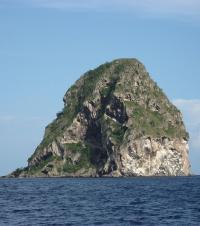
HMS Diamond Rock
As an American reading British Royal Navy history, I will admit to being initially confused, more than once, by “stone frigates“, naval establishments on land named as ships. HMS Collingwood, for example, is a stone frigate (shore establishment) of the Royal Navy, in Fareham, England. It is the lead establishment of the Maritime Warfare School.
Recently, I came across the history of the first “stone frigate,” HMS Diamond Rock of 1803. Diamond Rock is a 175-meter-high (574 ft) uninhabited basalt island located 3 kilometers from Pointe Diamant on the Caribbean island of Martinique. The rock gets its name from the reflections that its sides cast at certain hours of the day, which evoke images of a precious stone.
In September 1803 Commodore Sir Samuel Hood was assigned to blockade the bays at Fort Royal and Saint Pierre, Martinique. He occupied Diamond Rock, which held a strategic position off the island.
The British hoisted two 18-pounder cannons to the summit of the rock and supplied the position with food and water for a garrison of two lieutenants and 120 men under the command of Lieutenant James Wilkes Maurice, Hood’s first lieutenant. The British also placed two 24-pounder guns in batteries at the base of the rock, and a 24-pounder carronade to cover the only landing place. Hood officially commissioned the island as the “sloop” HMS Diamond Rock (a “stone frigate”).
While “HMS Diamond Rock” was in commission (as a “stone frigate”), Royal Navy ships were required, when passing the island, to show due respect, personnel on the upper deck standing at attention and facing the rock whilst the bridge saluted.
For 17 months, the fort was able to harass French shipping trying to enter Fort-de-France. The guns on the rock completely dominated the channel between it and the main island, and because of their elevation, were able to fire far out to sea. This forced vessels to give the rock a wide berth, with the result that the currents and strong winds would make it impossible for them to arrive in Port Royal. During this time the French troops on Martinique made several unsuccessful attempts to retake the rock.
In 1805, a Franco-Spanish flotilla overwhelmed the British position. After enduring a fierce bombardment, Maurice surrendered to the superior force on 3 June 1805, having resisted two French seventy-fours, a frigate, a corvette, a schooner, and eleven gunboats. The British lost two men killed and one wounded, and the French 20 dead and 40 wounded (English account), or 50 dead and wounded (French account), and three gunboats.
The subsequent court-martial of Commander Maurice for the loss of his “ship” exonerated him, his officers, and men and commended him for his defense.

Among other achievements in a wondrous life, Jol Byerly was first captain of ‘HMS’ Rose for her delivery from Lunenburg to Boston when she was launched in 1970. Here’s his report of some modern day action on ‘HMS’ Diamond Rock…
https://www.allatsea.net/jol-byerleys-apr-08-letter-from-antigua/
All interesting and educational info…
Thanks for sending it along…Hoping to see more…
Rob Leeson
A stone frigate was the focus of one of Dudley Pope’s entertaining Ramage novels – “Ramage’s Diamond” – inspired by Diamond Rock. It’s a fun read.
In 1969 I was the Meteorologist Mate (Leading Seaman) in HMCS ST LAURENT (RCN) . I worked for the Navigator who plotted a course to pass HMS Diamond Rock to port. The Captain rendered passing honours to this bit of navy history. In 1994, I was in command of HMCS CORMORANT, deployed to the Caribbean. I had my Navigator lay on a course to pass Diamond Rock and I paid passing honors to the same bit of navy history
I first encountered HMS Diamond Rock while reading Dudley Pope’s Lord Ramage series. But I was convinced at the time (pre-internet)that this was a clever but totally fictional episode, right up there with “springs on cables”.
Imagine my chagrin when I realized truth is stronger than fiction.